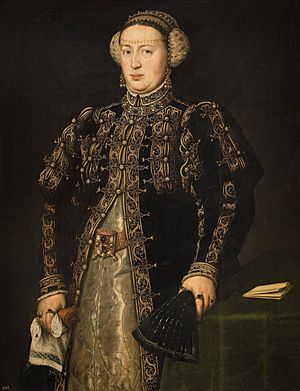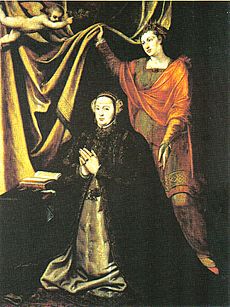Catherine of Austria, Queen of Portugal facts for kids
Quick facts for kids Catherine |
|
|---|---|

Portrait by Anthonis Mor, 1552
|
|
| Queen consort of Portugal | |
| Tenure | 10 February 1525 – 11 June 1557 |
| Born | 14 January 1507 Torquemada, Crown of Castile |
| Died | 12 February 1578 (aged 71) Ribeira Palace, Lisbon, Kingdom of Portugal |
| Burial | Jerónimos Monastery |
| Spouse | |
| Issue among others... |
Maria Manuela, Princess of Asturias João Manuel, Prince of Portugal |
| House | Habsburg |
| Father | Philip I of Castile |
| Mother | Joanna I of Castile |
| Religion | Roman Catholicism |
| Signature |  |
Catherine of Austria (in Portuguese: Catarina; born January 14, 1507 – died February 12, 1578) was the Queen of Portugal. She became queen when she married King John III. Later, she also served as a regent, ruling Portugal for her grandson, King Sebastian, from 1557 to 1562, while he was still a child.
Contents
Early Life of Catherine of Austria

Catherine was born in Torquemada, Spain. She was an Infanta (a princess) of Castile and an Archduchess of Austria. Her father, King Philip I, died before she was born, so she was his posthumous daughter. Her mother was Queen Joanna of Castile. Catherine was named after her aunt, Catherine of Aragon.
Catherine grew up with her mother, who was often unwell. All of Catherine's five older brothers and sisters, except Ferdinand, were raised in the Low Countries by their aunt. But Queen Joanna kept young Catherine with her. Catherine stayed with her mother even when her mother was kept at Tordesillas. When it was time for Catherine to marry, she was finally allowed to leave.
Catherine as Queen of Portugal
On February 10, 1525, Catherine married her first cousin, King John III of Portugal. They had nine children together. Sadly, only two of their children lived past early childhood.
Catherine cared a lot about her family's education. She collected many books for her library. She also created a special gathering place, like a salon, at the royal court. Here, smart people could meet and discuss ideas. She invited many women scholars to her home. These included Joana Vaz and Públia Hortênsia de Castro, who were humanists (people who studied human culture). The poet Luisa Sigea de Velasco also joined them. Joana Vaz helped teach Catherine's daughter, Princess Maria. She also taught Catherine's niece, who was also named Maria and was a scholar herself.
After her husband died in 1557, Catherine became the regent for her grandson, King Sebastian. He was still a baby. Her daughter-in-law, Joan of Austria, also wanted to be regent. Charles V, who was Catherine's brother, helped solve the problem. He decided that Catherine should be the regent. This was because Joan was needed in Spain.
Catherine served as the regent of Portugal from 1557 until 1562. In 1562, she handed over the regency to Henry of Portugal.
Catherine's Amazing Collections
Catherine had one of the first and best collections of Chinese porcelain in Europe. She was the youngest sister of Emperor Charles V and the Queen of Portugal. This position allowed her to get many rare items. She bought lots of porcelain and other unusual things from Asia. These items arrived regularly in Lisbon. She used them to decorate the royal palace and for her own use. These collections showed her power and wealth.
Her collection became the first kunstkammer (a room filled with rare and interesting objects) in Spain and Portugal. She was following a tradition started by King Manuel I of Portugal before her. He had bought porcelain for his wife, Maria of Castile.
Among the many interesting things in Catherine's collection were:
- Fossilized sharks' teeth
- A snake's head covered in gold
- Heart-shaped jasper stones, believed to stop bleeding
- A coral branch, thought to protect against evil spirits
- Bezoar stones (lumps found in animal stomachs, believed to be antidotes)
- A unicorn's horn (which was actually a narwhal tusk)
- Piles of loose gems and stones like rubies, emeralds, and diamonds
Catherine's Children
Catherine and King John III had nine children. However, most of them died very young. Only two of their children survived into adulthood: Maria Manuela and João Manuel.
| Name | Birth | Death | Notes |
|---|---|---|---|
| With John III, King of Portugal (married 10 February 1525) | |||
| Prince Afonso | 24 February 1526 | 12 April 1526 | Prince of Portugal (1526). |
| Princess Maria Manuela | 15 October 1527 | 12 July 1545 | Princess of Portugal (1527–1531). First wife of King Philip II of Spain. She had one child, Don Carlos, and died four days after his birth. |
| Infanta Isabella | 28 April 1529 | 22 May 1530 | |
| Infanta Beatrice | 15 February 1530 | 16 March 1530 | |
| Prince Manuel | 1 November 1531 | 14 April 1537 | Prince of Portugal (1531–1537). Declared heir in 1531. |
| Prince Philip | 25 March 1533 | 29 April 1539 | Prince of Portugal (1537–1539). Declared heir in 1537. |
| Infante Denis | 6 April 1535 | 1 January 1537 | |
| Prince João Manuel | 3 June 1537 | 2 January 1554 | Prince of Portugal (1539–1554). Declared heir in 1539. Married Joan of Spain. Their son Sebastian became king. |
| Infante Anthony | 9 March 1539 | 20 January 1540 | |
Catherine has no living descendants today. Both of her grandchildren died without having children. Her family line ended very soon after her death. Her only grandchild who outlived her, King Sebastian of Portugal, died in August 1578, just six months after Catherine.
See also
 In Spanish: Catalina de Austria para niños
In Spanish: Catalina de Austria para niños

